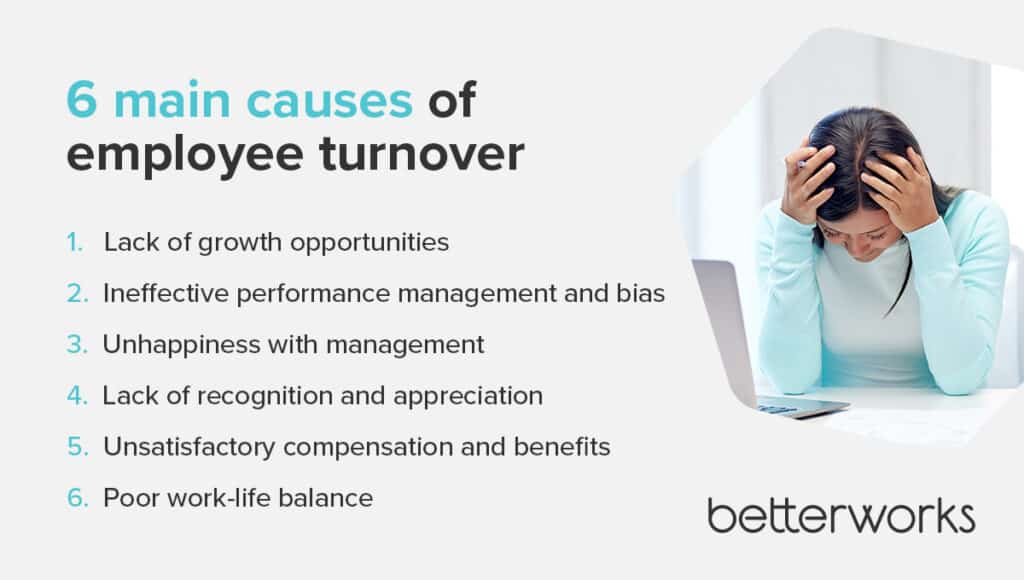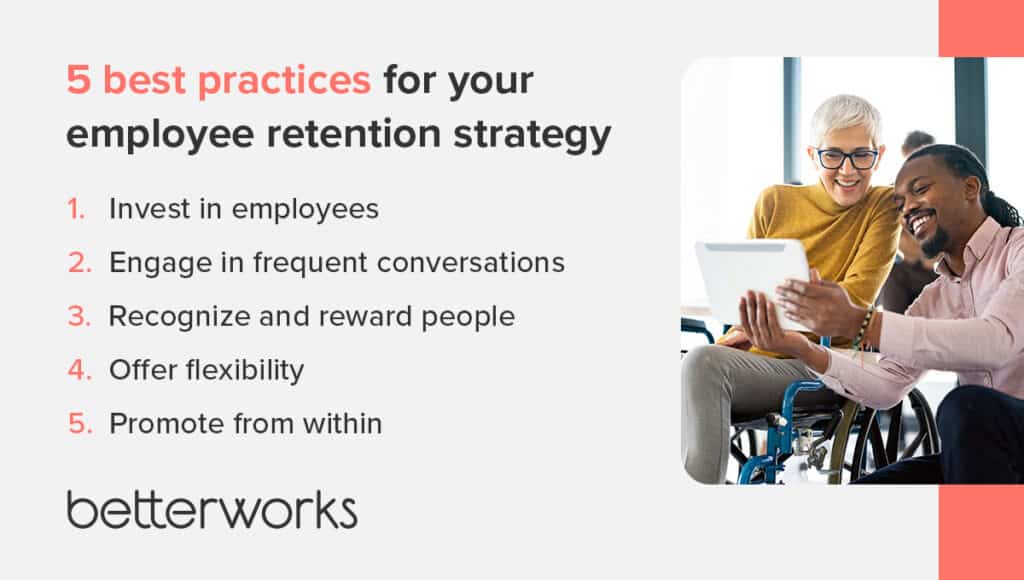The Great Resignation isn’t over even though it is subsiding. Despite highly publicized layoffs and fears of an economic downtown, 2022 was a record year for employee resignations. To attract and keep the best talent in a tight labor market, employers must figure out why people are quitting their jobs.
Employees have many good reasons for quitting. A Pew Research Center survey revealed that the top three reasons are low pay, poor opportunities for advancement, and feeling disrespected at work. Those are just some of the problems with the employee experience that contribute to voluntary turnover.
Learn more about the cost of employee turnover, the real reason everyone is quitting their jobs, and what goes into an effective employee retention strategy.
The cost of employee turnover
When employees leave, they create a ripple effect across their teams and even their organizations, influencing the financial health and operational efficiency of the business. High turnover rates amplify those effects, driving up the direct and indirect costs associated with people leaving their jobs.
Direct costs
The direct costs related to employee turnover include the time and expense of recruiting, hiring, and training people’s replacements. Job postings, background checks, and commissions to outsourced recruiters all fall into this category. Relocation assistance, such as travel and housing expenses, also comes into play for some roles.
Indirect costs
The indirect costs of turnover are harder to quantify, but they arguably have the bigger impact. This category includes lost institutional knowledge in the immediate aftermath of a departure. Even when replacements are found, they won’t be fully productive until after they finish onboarding.
Indirect costs aren’t limited to the people coming and going. The upheaval of high employee churn can also reduce engagement, morale, and productivity among the remaining workforce. New hires change the dynamics of a team, which can drag down operational efficiency while workers work to establish trust with new members.
Finding the root causes of employee turnover in your workforce
The only way to solve high turnover rates is by identifying and addressing the root causes, which could include culture issues, concerns over fairness and bias, inadequate pay, or lack of internal mobility, for example . Before taking action, investigate why employees are leaving and how you could have prevented their departures.
The factors influencing turnover might differ based on your organization’s size, industry, and workforce makeup. For example, employees with young children or dependent family members may look elsewhere in search of flexible work arrangements. Early-career employees, meanwhile, might quit if they feel there’s no room for career growth.
Check out some of the ways to pinpoint potential turnover in your workforce.
Ask team members for input
Survey employees to find out what they like best about the employee experience and where it falls short. Annual engagement surveys can gather some of this information, but you will often need to supplement those results with other feedback methods.
When people decide to move on, conduct exit interviews to learn why. Ask standardized questions, just like you do for a hiring interview, so each departing employee’s responses can be organized and assessed objectively.
Pinpoint trends in the data
Aggregate the data collected from survey responses and exit interviews. Areas to examine include job satisfaction, job expectations, workplace culture, career progression, and the quality of management. Identify trends in what employees expect from you, especially if you’re not meeting those expectations. If a high number of responses critique return-to-office edicts, for example, that’s the topic to probe further.
Once you’ve identified trends, consider pulse surveys or focus groups to dig deeper. Use this data to inform your employee retention strategy.
Breaking down the main causes of turnover
By understanding some of the main causes of turnover, organizations can create strategies to reduce it. Explore some of the most common reasons for quitting a job.
Lack of growth opportunities
Employees who don’t feel they can progress toward their career goals are more likely to become disengaged and look elsewhere — even if they enjoy their work.
Advancement is a powerful motivator, so if employees don’t feel their future is at your organization, you’ll see higher turnover as they find another career path. If they don’t leave, they might disengage and be less productive.
Ineffective performance management and bias
Employees who feel their company’s performance management processes don’t adequately capture their contributions or incorporate their career aspirations and goals may lose trust in the organization. If people perceive performance reviews as incomplete or biased, they may view them as a waste of time that doesn’t lead to better performance or appropriate compensation.

Unhappiness with management
When employees believe their direct manager isn’t supportive or micromanages them, they suffer from decreased morale and motivation, as well as a higher risk of turnover. Employees might also be unhappy with higher-level executives, including the CEO.
When employees don’t trust leaders or struggle to communicate, they’ll feel unwelcome — and are more likely to start job searching.
Lack of recognition and appreciation
Failure to sufficiently recognize and appreciate people has a significant impact on employee turnover. When employees don’t feel valued for their hard work, they may disengage or become resentful, which can lead to lower productivity and morale.
Lack of acknowledgement can also affect performance because employees don’t know where they stand or where they need to improve. If those employees are eventually surprised with negative feedback, they’ll feel even less appreciated and more likely to look for another job.

Unsatisfactory compensation and benefits
Unsurprisingly, employees who feel they’re underpaid and have a bad benefits package are more likely to seek these things from other employers.
Inadequate pay and benefits aren’t the only reasons employees stay or go, but they’re a fundamental component of any employee retention plan.
Poor work-life balance
When employees feel they’re overworked, underpaid, and unable to take time off, they’re more likely to become dissatisfied — and their productivity will likely plummet, too.
Part-time shift workers feel extra stress when they have irregular work schedules and little notice of changes. They’ll feel less valued and struggle to meet commitments outside the job. Meanwhile, full-time employees who regularly work extra hours might look for an alternative job that pays similarly but requires fewer hours.

Implementing an effective employee retention strategy
A successful employee retention strategy reduces turnover and the associated costs of recruiting and training new employees. It can also improve employee morale and engagement by showing that the company values its employees and is committed to keeping them happy.
Every organization must customize its employee retention strategy based on its needs. However, there are best practices for any company to follow. Learn more about how to implement this strategy at your organization.
Invest in employees
People want to contribute their best at work. Show them how you as an employer can help them achieve career growth through professional development programs, training, and skilling opportunities. Incorporate learning into an employee’s performance plan. Managers can monitor and encourage employee progress. Company-sponsored career growth builds employee loyalty and shows that you value them and their contributions.
Investing in people’s professional growth should be a core part of the manager-worker relationship. Train managers to act as career coaches who help their reports find aligned growth activities, including internal projects. They can help employees discover what they’re best at, what they want to achieve, and how to find the right learning path to get there.
Engage in frequent conversations
Communication is one of the most important elements of an employee strategy. When managers hold frequent check-ins with employees, they can learn about and address concerns that raise the risk of voluntary turnover. Managers benefit from training on how to have these regular conversations in a productive way. Their reports should always feel safe raising concerns without fear of retaliation.
One of the best places to improve communication is around performance management. When managers and employees regularly talk about performance, employees know where they stand and how to improve. Tracking that data in your performance management software gives everyone a clear view of progress and prevents surprises that hurt morale and engagement.
Recognize and reward people
Recognizing and rewarding employees for their hard work, accomplishments, and loyalty are essential components of a good employee retention strategy. Your total rewards strategy should encompass many approaches, from public recognition to bonuses and promotions.
Compensation and benefits are key elements of your total rewards program. To remain competitive, make sure your compensation aligns with market offerings. Consider expanding benefits to meet more of the needs of demographic groups within your workforce. Dependent care, student loan repayments, pet benefits, and mental health benefits are just some of the benefits more in demand by employees.
Offer flexibility
Many organizations have rethought rethinking the old archetype of work: The 8-hour workday, Monday to Friday, in an office. Fluid options that offer better work-life integration are increasingly in vogue — and in demand by employees who prioritize flexibility. You can be an employer of choice when you give flexibility in when, where, and how people work.
Do you need employees to come into the office every day, or can they work one or two days a week from home? Does every job role need to work the same hours, especially if much of the work is solo and asynchronous communication tools are available?. Employees want flexibility, and they want to see how you’re trying to meet that need.
Promote from within
Not every employee wants a promotion, but failing to offer internal promotions and lateral paths for growth is a surefire way to lose people. People value opportunities to stretch and grow, not to mention the added compensation that often comes with a new title or expanded responsibilites.
Show your employees that you’ll help them grow, even if that advancement isn’t in a straight line. Consider posting jobs internally first, as well as incentivizing managers to encourage their employees to try out other roles in the company.

Combat turnover to drive the business forward
Employees want to work in jobs that meet their needs — and they’re willing to leave if that’s not the case. As HR leaders, it’s your job to ensure your employees have a work environment that’s fulfilling, rewarding, and satisfying.
When you determine why people are quitting, you can address those problems, improve workplace conditions, and increase compensation, benefits, and growth opportunities for your workforce. By investing in employee retention, you create a culture that meets the needs of your workforce while helping the business thrive.
Is employee turnover avoidable? Check out research from Betterworks on the impact of performance enablement in combating turnover.
Is employee turnover avoidable?









